Posted by Anita on 10.31.07 7:05 AM
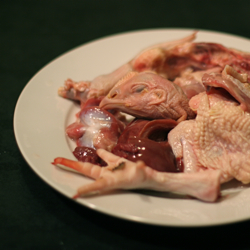 Once upon a time, there was a spoiled teenager named Anita who refused to eat ribs, chicken legs, or any other meat shaped like a body part.
Once upon a time, there was a spoiled teenager named Anita who refused to eat ribs, chicken legs, or any other meat shaped like a body part.
One year, the child’s mother took ill on Thanksgiving morning, with a gaggle of relatives due to descend upon the family home in mere hours. The mere thought of sticking her hand inside (inside!) the body of a turkey made the girl turn green around the edges, but there was nothing to it but to do it: In went the hand, out came the slimey giblet bag. In a word: Gack!
Years later, the girl grew up and got over herself. A culinary school butchery class, which involved parting out cases of chickens and breaking down sides of beef, rid her of the last vestiges of meat squeamishness. The woman became secure with her place on the food chain, an unrepentant carnivore at last.
Flash forward to 2007: In a crisis over the disappearance of Hoffman Farms chickens from the local farmers market, we started buying our weekly roaster from Marin Sun Farms. We’d blithely strolled past their stand for months, seeing the signs for chickens, never venturing in to price them; our Hoffman loyalties were that strong. But the disappearance of their main competition emboldened these farmers, and they began putting their wares on more prominent display: First in bins by the edge of their stall, then moving to a large, copiously iced display — complete with protruding chicken feet — right out in the pathway. (Just the other day, I saw a group of tourists laughing nervously and taking pictures; it’s quite the sight if you’re not used to such things.)
The first afternoon of our patronage, we brought our fine-footed fowl home. The idea of cutting off chicken feet didn’t faze me a bit, I smugly noted. It wouldn’t be any worse than snipping off wingtips, really. I’d seen enough dim sum to grasp the comic possibilities of disembodied chicken feet, and I knew their gelatinous cartilage would add body to our next batch of stock.
I plopped the bagged bird in the sink and turned on the water. Cutting through the rubber band that held the bag shut, I accidentally grazed my arm on a stray claw. (Note to self: Chickens — at least the ones that aren’t factory-gorged on corn — scratch for their supper.) But the sting of avian revenge was no match for the shock I got when I pulled Henny Penny out of the bag: Her frickin’ head was still attached!
Or, well, mostly attached. The neck had been slashed (quite tidily) and her noggin wobbled around on the impossibly long neck in a rather ghastly fashion. Her tiny eyes were mercifully shut, but you could quite clearly make out what her features must have looked like, mere days ago. A tiny comb was clearly visible at the crown of her egg-sized skull. Oh, my…
Snapping out of my guilt-laden reverie, I laughed aloud, amused at how a small, dead hen could rattle me so. Would I have bought her, had I know she came fully equipped? Probably. But coming upon an unexpected beaky face in the bottom of the bag was more than I was expecting. I wondered whether the farmers enjoyed imagining the shock they inflicted on unsuspecting city slickers, but most likely they never gave it a moment’s thought. It’s a chicken, to them. Their livelihood, our supper.
It gets easier, week by week, staring my dinner in the face on a Sunday afternoon. I’ve even come to see the gallows humor in the macabre ritual of removing heads, necks, and feet. I’m not sure I could ever kill a chicken, maybe not even gut a dead one (I’m still not all that happy about innards, truth be told). But if I’m going to be an ethical carnivore, I figure that looking my meat in the eye is the least I can do. And so I do, with silent thanks to the farmer and the chicken.
And then I cackle like a fiend as I throw the dismembered bits in the stockpot. Muuu-huuu-huuu-ahhh!

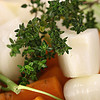



Chicken Stock, Simplified
4 to 5 pounds raw or frozen chicken bits (wings, backs, necks, and feet)
6 quarts filtered water
1 pound mirepoix, very large dice (1 inch or so)
– 1 large onion
– 2 medium carrots
– 2 large celery stalks, trimmed
Bouquet garni
– 2 cloves garlic
– 8 peppercorns
– 3 whole cloves
– 2 fresh thyme sprigs
– 6 parsley stems
…tied with twine in a cheesecloth bundle
In your largest pot, bring water and chicken parts to a simmer; reduce to a lazy bubble and cook for 3 hours. Add the mirepoix and bouquet garni and cook for an additional hour. Strain through cheesecloth or a very fine mesh sieve into a large bowl (or a cool stockpot). Cool to room temperature using an ice-water bath or immersible stock chiller, then chill completely overnight.
The next day, skim the fat and measure stock in 2-cup portions into quart-size freezer bags. Holding the bag upright, squeeze to remove excess air, then seal. Freeze bags flat on a rimmed cookie sheet until completely solid; they can then be stored in your freezer’s pull-out bins, filed like flip-cards along with pasta sauce and other flat-packed liquids. Any odd measures of stock can be frozen in ice-cube trays for quick use in pan sauces and other recipes requiring small amounts of liquid. Store frozen stock for up to 6 months.
cooking, farmers markets, locavore, meat, recipes
16 Comments »




Posted by Anita on 10.28.07 7:50 PM
 When my mom was growing up, homemade dessert was a regular occurrence around the dinner table. By the time I was a kid, the family tradition had lapsed; cakes and pies showed up mostly around the holidays or on someone’s birthday. Not that I felt deprived: To this day, my idea of dessert is scraping the bowl for the last spoonful of mashed potatoes, or sneaking an extra meatball from the lunch-bound leftovers.
When my mom was growing up, homemade dessert was a regular occurrence around the dinner table. By the time I was a kid, the family tradition had lapsed; cakes and pies showed up mostly around the holidays or on someone’s birthday. Not that I felt deprived: To this day, my idea of dessert is scraping the bowl for the last spoonful of mashed potatoes, or sneaking an extra meatball from the lunch-bound leftovers.
Despite my defective sweet tooth, I love to bake for friends and family. At my office in Seattle, I belonged to a crew of hard-core amateur pâtissières dubbed the Spare Change Bakery. We all kept jars on our desks for our coworkers’ contributions, and as soon as we scraped together enough nickels and dimes, one of us would whip up a double- or triple-batch of something sweet and scrumptious for the next staff meeting. By the time we disbanded, we were collecting enough cash to bake every week — a gratifying but rather exhausting sign of our popularity.
But since we moved back to San Francisco, I haven’t had many excuses to bake. Sure, our dinner parties often need a sweet ending, but I miss those crowd-pleasing desserts: Brownies, bars, and other decidedly lowbrow sweets. So when I saw the photo of the Spice Cake with Coffee Toffee Crunch on the cover of the new issue of Sunset, I knew my path was clear. The theme for this month’s “Waiter, There’s Something in My…†event is layer cakes, after all, and there’s just something about a sky-high cake with cream-cheese frosting that sends me running for my sifter and whisk.
 Working my way through the recipe, I found it refreshingly well documented. The writer details a number of steps — creating a crumb coat, and using strips of parchment to keep the serving plate clean — that help give the final cake a centerpiece-worthy appearance. With the exception of the recipe’s lack of measurements by weight (the serious baker’s preferred method for dry ingredients like flour and sugar, especially), it was one of the best-written magazine recipes I’ve used in months.
Working my way through the recipe, I found it refreshingly well documented. The writer details a number of steps — creating a crumb coat, and using strips of parchment to keep the serving plate clean — that help give the final cake a centerpiece-worthy appearance. With the exception of the recipe’s lack of measurements by weight (the serious baker’s preferred method for dry ingredients like flour and sugar, especially), it was one of the best-written magazine recipes I’ve used in months.
Aside from substituting Alfieri Farms’ almond brittle for homemade coffee toffee, I followed the recipe to the letter, so click over to Sunset’s site if you want the full rundown. Although I doubt the magazine’s suggestion that this cake will replace pumpkin or pecan pie on your holiday dessert buffet, it’s got a spicy, deep flavor that would make a perfect finish for an autumn feast. While the icing’s got enough sugar to satisfy even the most intense sugar junkie, the cake itself — sweetened with molasses — keeps things moist and spicy without too much sweetness… just the ticket for a baker without a sweet tooth.





baking, dessert, magazines, other blogs
10 Comments »




Posted by Anita on 10.26.07 7:04 AM
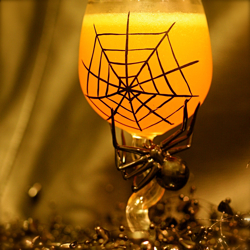 Despite its spooky name and eerie orange glow, Satan’s Whiskers is not the least bit diabolical. Unlike many vintage cocktails that shape-shifted their way across the decades, this drink’s somehow kept its original form throughout time.
Despite its spooky name and eerie orange glow, Satan’s Whiskers is not the least bit diabolical. Unlike many vintage cocktails that shape-shifted their way across the decades, this drink’s somehow kept its original form throughout time.
Both the Savoy Cocktail Book and Patrick Gavin Duffy’s Official Mixer’s Manual call for equal parts gin, sweet vermouth, dry vermouth, and orange juice, plus half as much Grand Marnier as gin, and a dose of orange bitters. Some sources call for equal parts of all the ingredients and a dash of bitters; others hew to a half-measure of liqueur and also decrease the juice.
Truth be told, there’s more variation to be had from using different brands of vermouths (especially the sweet varieties) than any of these minor tweaks will afford; we like the flavor of Cinzano Rosso best, both on its own and mixed in the Whiskers. We used Sarticious gin — yet another local liquor, distilled over the hill in Santa Cruz — but any straightforward dry gin will do the trick.
Being great lovers of compromise, our recipe below is mostly Savoy, with a little extra bitters. If your liquor cabinet lacks Grand Marnier, you can substitute orange curacao for a variation known as “curled”. And if autumn’s chill gives you a craving for dark spirits, you might follow the lead of our friends at the Zig Zag Cafe, who make a delicious alternative dubbed Satan’s Soulpatch, replacing the gin with bourbon.





Satan’s Whiskers (Straight)
3/4 oz dry gin
3/4 oz sweet vermouth
3/4 oz dry vermouth
3/4 oz fresh-squeezed orange juice
1/2 oz Grand Marnier
2-3 dashes orange bitters
Shake all ingredients with ice; strain into a chilled cocktail glass.
For Satan’s Whiskers (Curled): Substitute orange curaçao for the Grand Marnier
For Satan’s Soulpatch: Substitute bourbon for the gin

1 year ago: Corpse Reviver #2
Drink of the Week, drinks, recipes
5 Comments »




Posted by Anita on 10.23.07 1:37 PM
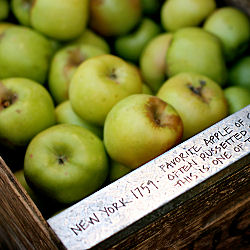 When I think about the bloggers participating in the Dark Days Challenge in places like Maine or Minnesota or Michigan — places where winter actually involves snow, frost, and farmers markets that close for the season — I feel like a fraud.
When I think about the bloggers participating in the Dark Days Challenge in places like Maine or Minnesota or Michigan — places where winter actually involves snow, frost, and farmers markets that close for the season — I feel like a fraud.
We still had tomatoes at our market this weekend — heirlooms and Early Girls and a rainbow of Sweet 100s — from a surprising number of farms. They sat there in their little cliques, cozying up to their buddies, red peppers and basil. You could almost imagine them standing in front of a mirror inspecting their own summery plumpness and silently mocking the homespun pumpkins and Brussels sprouts on the next table over.
Frankly, I’m over these cheeky girls of summer. I’m ready for the potatoes and the greens and the crisp new apples. It’s a little eerie to realize that I could eat today the same meals we made in June without even leaving the market. I even saw three different vendors who were still selling strawberries… they’ve been on the farm tables since the first week of April, for goodness sake. I’ll be sad when the pasture-raised chickens come to an end, but that’s really all I’m going to miss from summer. Autumn is my favorite eating season.
 We started out our Dark Days Challenge last week with some of our favorite standbys. We make these dishes a lot, and we’re pretty dialed in on where to find their ingredients from local sources. And I suppose that’s one of the benefits of eating locally all the time: With the exception of farmers dropping out of your market, you pretty much know where to find your favorite things, after a while. You also know, eventually, what’s hard (or even impossible) to find; it makes you more alert when you spy something you haven’t found locally before.
We started out our Dark Days Challenge last week with some of our favorite standbys. We make these dishes a lot, and we’re pretty dialed in on where to find their ingredients from local sources. And I suppose that’s one of the benefits of eating locally all the time: With the exception of farmers dropping out of your market, you pretty much know where to find your favorite things, after a while. You also know, eventually, what’s hard (or even impossible) to find; it makes you more alert when you spy something you haven’t found locally before.
Speaking of which, our friend Cookie turned me on to a local source for wheat flour and polenta. Although Full Belly Farms is about 100 miles away, they don’t come to my local market — they sell at weekday markets in places I can’t get to during the workday, plus one Saturday market down in Palo Alto, 30+ miles south of us. So now I get to make the choice about whether it’s better to drive an hour to buy the local option, or stick with my carb exemption. The other good news is that I found out (from Cookie, again) that the white rice we’ve been buying is harvested semi-locally… about 150 miles away.
Here’s what last week looked like:
Chicken & Dumplings
– Marin Sun Farms chicken; onions, carrot, celery from the market; garden herbs
– biscuit mix from Beth’s in San Rafael; Clover Organic milk
Chili Dogs (can’t watch the playoffs without ‘dogs!)
– Prather Ranch uncured hotdogs and Acme pain de mie buns
– Chili made with our own tomato sauce and homemade pork sausage, plus Prather chuck
– Eatwell Farms onions, and non-local (but organic) cheese
Oxtail Ragu and Pasta
– Marin Sun Farms oxtails braised with our own chicken stock and tomato sauce
– salad: red-leaf lettuce (Little), avocado (Will’s) and tomatoes (Everything Under the Sun)
– non-local dried orecchiete pasta
Pork & Potatoes
– Double-cut Prather Ranch pork loin chop on the grill
– Roasted Iacopi Farm brussels sprouts with Bariani olive oil
– Roasted ‘rose Finn apple’ potatoes from Mr. Little
Pasta (Not-Quite-)Bolognese
– meat sauce made with Prather beef and pork, Mariquita tomatoes, Eatwell onions
– garlic bread: Clover Organic butter, Acme rolls, local garlic
– non-local dried pasta
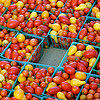


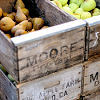
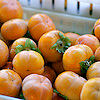
farmers markets, locavore, other blogs
10 Comments »




Posted by Anita on 10.19.07 7:02 AM
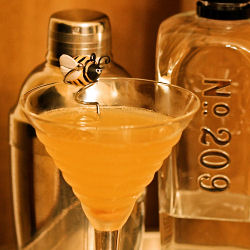 Last weekend, Cameron and I spent the better part of our monthly cocktail budget on a pair of tickets to the Independent Spirits Fest. Although my mom thought it sounded like the kind of groovy gig where you’d follow your bliss, it’s actually a trade show for distillers who aren’t aligned with any of the booze juggernauts.
Last weekend, Cameron and I spent the better part of our monthly cocktail budget on a pair of tickets to the Independent Spirits Fest. Although my mom thought it sounded like the kind of groovy gig where you’d follow your bliss, it’s actually a trade show for distillers who aren’t aligned with any of the booze juggernauts.
One of the best Fest perks was the opportunity to taste a number of liquors you can’t easily put your hands on, either because they’re too rare (often combined with “too pricey”), or too new to find in stores. With more than 30 exhibitors filling two small conference halls, we decided to focus on those near to our heart: Folks making booze in Northern California.
Between us, we tasted 20+ locally-produced items from a dozen different producers over the course of the evening. (Don’t worry: Most ended up in the spit bucket, and we took a cab home.) Some names you’d recognize from the shelf of your local bar, like Junipero gin and Hangar One vodka. But many new-to-us discoveries — like St. George’s lovely single malt, a bierschanaps made in Mountain View, and Charbay’s haunting pastis — were almost worth the cost of admission.
Best of all, it was a treat to find so many liquors produced within 100 miles of our home bar. Of the major booze families, I think we’re really only lacking a local American-style whiskey (one’s coming soon from Pioneer Spirits in Chico, with any luck) and a tequila equivalent, which can only be a matter of time given the mezcal explosion and the Bay Area’s love affair with agave.
But even after Wednesday’s Dark Days post, I can’t say that we’re going totally loca-boire. I think it’s safe to say, however, given the diversity of what we found — gin, whisky, rum, vodka, brandies, eaux de vie, liqueurs of all sorts — you’ll start seeing a lot more local products on our shelf, and on the blog.
—-
But on to this week’s drink: I’d been playing with honey drinks for a while, but it wasn’t until I sat down with my brand-new (to me) copy of David Embury’s classic The Fine Art of Mixing Drinks that I found one that really appealed to my tastes. Early in the book, Embury holds forth on the dark days of Prohibition and the birth of a number of “pernicious” cocktails, including a concoction christened the Bee’s Knees — equal parts honey, lemon, and gin. Thankfully, the days of bathtub gin are long behind us, and the modern version of the drink (which Embury endorses in later chapters) calls for saner proportions.
The glorious thing about the Bee’s Knees — which fully lives up to its name — is that it’s another one of those drinks you can easily make with ingredients you keep around the house. And, if you’re lucky like us, even with ingredients grown or distilled within a few miles of home. Careful observers will note it’s a close relative of the Whiskey Sour, and it shares that drink’s easygoing ways.
Although they weren’t exhibiting at the Fest, our favorite white liquor these days is sassy 209 Gin, distilled along the San Francisco waterfront at Pier 50 (a full 6 miles from our door, if you’re counting). It’s a lovely, mixable spirit, well-balanced but spunky.
The honey we get from Meeks’ in Soquel (72 miles) is fairly solid stuff. To bring it to a spreadable consistency, we usually warm the jar in a small saucepan of water. Alas, that’s not such a clever idea when mixing drinks: Hot honey isn’t exactly conducive to a crisp and cool cocktail, and it seizes back up as soon as it hits the ice. The problem’s easily remedied by using honey syrup: Heat equal parts honey and water in a pan, stir until dissolved, then pour into a bottle for storage (in the fridge, please).
Last but not least, there’s lemon juice. Although local honeybees are big fans of our backyard Meyer lemon tree, its current crop of fruit isn’t quite ripe. Luckily, a number of the farmers at the Ferry Building market keep us well supplied with Eureka lemons. In a few weeks, when our lemons turn yellow at last, this drink’ll get about as local as can bee.


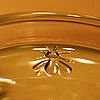


Bee’s Knees
2 oz dry gin
1 oz lemon juice
1 oz honey syrup
Shake all ingredients with ice, and strain into a chilled cocktail glass.
———-
Drink of the Week, 1 Year Ago: Moscow Mule
Drink of the Week, drinks, locavore, recipes
17 Comments »




Posted by Anita on 10.17.07 7:35 AM
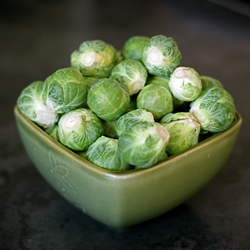 So many variables factor into the bounty of the Bay Area’s foodshed: The density and affluence of our population creates a bumper crop of food-obsessed consumers, our progressive social milieu fosters an interest in sustainability, and the richness of our restaurant scene rewards ambitious farmers.
So many variables factor into the bounty of the Bay Area’s foodshed: The density and affluence of our population creates a bumper crop of food-obsessed consumers, our progressive social milieu fosters an interest in sustainability, and the richness of our restaurant scene rewards ambitious farmers.
But underneath all that is the inescapable fact that we live in one of the most fertile food-growing regions in the country. Add to that an eye-crossing number of microclimates, and the result is an astounding variety of warm-weather crops from just-spring to deep autumn. Even in winter, our markets offer an almost unbelievable abundance.
I know that most other regions don’t have it so easy; reading the seasonal posts of other food bloggers brings that fact home. Eating locally, especially year-round, can be a struggle for even the most dedicated fanatic. In most areas, the first frost pretty much spells doom for the locavore agenda, save for home-preserved harvests, hardy winter crops, and often-pricey meats and cheeses.
So when I read on the Eat Local Challenge blog that an autumn-into-winter locavore event was afoot, I had to check it out. Laura — who writes a charming blog called Urban Hennery out of Everett, Washington — is blogging her latest experiment: Feeding herself, her husband, and her friends on local foods throughout the remainder of the year. She’s challenged anyone interested to join her, christening the event the Dark Days Challenge.
I signed on with Laura without giving the idea much thought… without realizing that this snap decision means we’re going to become a lot more candid about the choices we’re making when we shop. This isn’t just a one-week flirtation with locavore exhibitionism, as we’ve done before. But I know we can do it because it’s what we’ve been doing pretty much all summer long, on the sly. And, honestly? Not doing it here — in what must be the easiest place in the country to attempt this challenge — would feel churlish.
My name’s Anita, and I’m …a locavore. There, I said it.
All joking aside, I’ve been bashful of talking about what we’re doing, mostly because I am leery of sounding sanctimonious or self-congratulatory. Food choices are incredibly personal, and if you have strong opinions about what you eat and why, it can be hard to talk about them without seeming snobbish. Or condescending. Or egotistical. Or just vain.
So, in order to salve my fears, I’ll say this and then trust that you’ll give us the benefit of the doubt: Eating sustainable, local, and organic food whenever possible is important to us. But by sharing what we’re doing, we are in no way condemning anyone else’s choice.
Enough of that, and full speed ahead. We’re on this bandwagon for the full ride. Expect to hear about our locavore adventures — the triumphs and the challenges, as Laura says — throughout the fall. We’ll continue to eat as locally as we can as often as we can, and write about it at least once a week until New Year’s Day.
 Laura has encouraged her Dark Days cohorts to modify the house rules to suit their circumstances. Based on our experience in past challenges, we’ve held ourselves to a harder line with some items (like produce miles) and taken a more realistic approach to others (like carbs). Here’s our general game-plan:
Laura has encouraged her Dark Days cohorts to modify the house rules to suit their circumstances. Based on our experience in past challenges, we’ve held ourselves to a harder line with some items (like produce miles) and taken a more realistic approach to others (like carbs). Here’s our general game-plan:
- We will continue to cook locally as often as we can, with a baseline of two dinners per week made from 90% local ingredients.
- We will write about at least two meals a week made with as many local ingredients as we can source.
- Local for us will be a 100-mile radius for produce and a 200-mile radius for protein. Strong preference will be given to items purchased direct at the farmers market rather than retail.
- We’re making the usual ‘Marco Polo’ exemptions for seasonings. We’re also making exceptions for flour, dried pasta, white rice, and polenta — we have no local sources of these ingredients, and man does not live by potatoes and bread alone. We will try to source baking ingredients locally, but I don’t expect to find much beyond nuts, and I won’t go through the holidays without baking.
- We’ll try to limit processed foods to those produced within a 50-mile radius. We’ll try to determine how much local ingredient sourcing they’re doing, and talk about it in our posts.
- We’ll continue with the challenge through the end of the year, and then re-evaluate on New Year’s Day along with other participants.




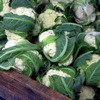
locavore, other blogs
8 Comments »




Posted by Anita on 10.16.07 12:02 PM
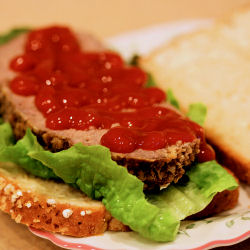 You learn the darndest things when you blog.
You learn the darndest things when you blog.
Here’s just one example: Until a few days ago, I never knew that one of my all-time favorite foods was so widely appreciated. I mean, I knew meatloaf sandwiches were something other people ate, but I had no idea they loved them as much as I do.
That is, until the day I posted this photo on Flickr and the comments started rolling in:
“One of the best uses of leftovers of all time.”
“Nothing better [than a meatloaf sandwich].”
I’m right there with them. I may love meatloaf sandwiches even more than I like the original meatloaf dinner. Which is impressive, considering my adoration for baked potatoes knows no bounds.
For those of us in the meatloaf-sandwich-lovers clique, there’s no need to wait for a special occasion to celebrate. But in case you’re seeking an excuse, Serious Eats declared this Thursday National Meatloaf Appreciation Day, and we’re all invited to play along.
Don’t tell me that you don’t have a prized family recipe to bring to the party? Oh, you poor thing. Here… pull yourself together. Sit down and let me give you a copy of ours.
But first, a few caveats:
Our family meatloaf is a bit of an anomaly. It doesn’t come topped with pan gravy, or even a tomatoey glaze. (Although Heinz ketchup is a mandatory condiment, as far as I’m concerned, it’s absent from the cooked dish.) This recipe also eschews breadcrumbs as a binder; Quaker Oats serves that purpose. An unorthodox choice, to be sure, but the end result is less bizarre than you might expect.
In place of the usual middle-American seasonings, our meatloaf features some strange-sounding spices. Happily for any purists among us, they fly under the radar, adding their warmth without making anyone think of an oatmeal cookie. Perhaps the biggest heresy of all: This meatloaf isn’t baked, or even shaped, in a loaf pan. Sporting the freeform curves of a football (make that ‘rugby ball’ outside the US), our odd-shaped loaf maximizes the crusty edges our family covets.
And because the resulting slices are just a teeny bit wider than the average piece of bread, the elliptical shape yields some delicious trimmings — perfect nibbles during the next day’s sandwich-making activities. Lucky you.
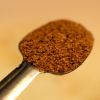
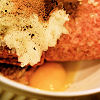

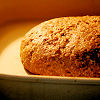

Mom’s Meatloaf
1-1/2 pounds ground chuck
1/2 pound pork breakfast sausage
1 onion, grated
1 egg
1 cup uncooked oatmeal (not instant)
1/4 cup milk
1 tsp salt
1/4 tsp ground black pepper
1/2 tsp nutmeg
1/2 tsp allspice
Preheat oven to 350°F. Combine all ingredients in a large bowl until well mixed. Pat into a football shape and place in a wide baking dish or a small roasting pan. Bake for 75 minutes, or until juices run clear when the center is pierced with a knife.
family, meat, other blogs, recipes
12 Comments »




Posted by Cameron on 10.15.07 7:02 AM
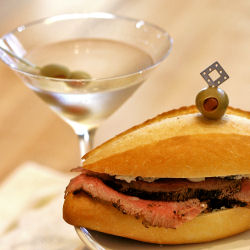 A big shout out to Natalie over at The Liquid Muse for choosing food/cocktail pairings as the Mixology Monday topic for October. My proposal for a decadent lunch (or bachelor’s dinner) is a steak and bleu cheese sandwich paired with an ice-cold Martini — one of my all-time favorite combinations.
A big shout out to Natalie over at The Liquid Muse for choosing food/cocktail pairings as the Mixology Monday topic for October. My proposal for a decadent lunch (or bachelor’s dinner) is a steak and bleu cheese sandwich paired with an ice-cold Martini — one of my all-time favorite combinations.
This is no tame, civilized snack. The sandwich should be rough and ready. You’ll need slices of cold beef left over from the loud debauchery at the grill Saturday night; a good, chewy roll; a wedge of bleu; plus a spreading knife and the guts to use it.
No lettuce. No mayonnaise. No mustard.
This particular Martini you want to be rippingly cold and (to borrow a winning concept from The Art of the Bar) made with Atomic Age proportions of gin and vermouth. Skip the orange bitters; you’ve already got a lot of flavors coming together.
Consume while watching a sporting match, taking in an action flick, or plotting your next corporate takeover.




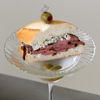
Steak and Bleu Sandwich
Cold sliced steak
Bleu cheese at room temperature
Chewy sandwich roll
Slice open roll. Spread several healthy swipes of bleu cheese on both halves. Layer bottom half with steak slices, and top with the other half. Eat.
 Atomic-Age Martini
Atomic-Age Martini
2 oz gin
1/2 oz (or less) dry vermouth
Combine ingredients in an ice-filled mixing glass. Stir until icy cold. Strain into a chilled cocktail glass, and garnish with an olive or two.
drinks, meat, Mixology Monday, other blogs, recipes
6 Comments »




Posted by Anita on 10.12.07 10:57 AM
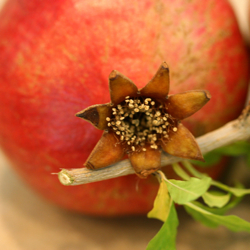 Las Vegas is perhaps the last place on the planet you’d expect to find anyone attempting to practice the locavore lifestyle. It’s the kind of city, after all, where restaurants brazenly tout their ‘locally caught salmon’ knowing full well that the closest ocean lies more than 300 miles away. (Perhaps they’re secretly stocking Lake Mead with King and Chinook?)
Las Vegas is perhaps the last place on the planet you’d expect to find anyone attempting to practice the locavore lifestyle. It’s the kind of city, after all, where restaurants brazenly tout their ‘locally caught salmon’ knowing full well that the closest ocean lies more than 300 miles away. (Perhaps they’re secretly stocking Lake Mead with King and Chinook?)
But the evidence that times are a-changing is there in black and white: Wednesday’s Review-Journal Living section featured a front-page story on chefs seeking out local purveyors and farmers attempting to create a market for their produce. To my surprise, a fair number of crops are grown within an hour’s drive of Sin City, just over the hill in Pahrump — a town better known for its ‘chicken ranches‘ than its vegetable farms.
And there’s more good news, quite literally just over the horizon. Although the Las Vegas Valley’s extreme temperatures — well over 100 in the summer and occasionally below freezing in winter — make large-scale farming nearly impossible, the nearby valleys of Southern Nevada can support a wide variety of carefully selected crops. Although water-intensive fields of alfalfa and grain are out of the question, the article points out that water-conscious drip irrigation (much like the kind we use in our own mini-orchard) is particularly well-suited to food crops grown for humans, rather than livestock. The UNLV cooperative extension specialists are working with folks interested in raising “everything from natural beef and pheasants to vegetables and fruit”, right within shouting distance of the neon and nightlife.
It’s a fascinating article about a region in transition. One only hopes they gain some traction before the local housing boom puts pressure on farmers to sell out to developers of yet another slapped-together townhouse pod.
The story arrived too late for me to explore many of its finds — the lone retail farmer mentioned operates a stand only from June through September. But I’m ecstatic to read that Whole Foods has her farm, and presumably others like it, under contract for next year’s harvest. The last time I was in town, just months ago, the local Whole Foods in Henderson was trucking in every last apple and avocado they sold all the way from our very own Central Valley. Most of their produce had travelled almost as far as I had, and some even hailed from another hemisphere. I suspect we have Michael Pollan to thank for this radical change, for holding Mr. Mackey’s feet to the fire.
—–
You can even find backyard edibles from green-thumbed gardeners making the most of their fickle surroundings. Some Asian friends have a few makrut lime trees, and another grows cilantro so prolifically that she can share giant batches with her friends. The neighbor up the hill has wide-paddle cactus along his fence; I doubt he’s making nopales, but we do see him harvesting tunas with a pliers now and then. (Let’s hope he’s making Margaritas with the juice.)
But although you might expect to find edible cacti among the sand and sagebrush, the desert is full of other surprises. On my last full day in town, Mom’s friend from across the street arrived bearing a pair of picture-perfect pomegranates from her own backyard. It’s one of those smack-your-forehead discoveries: These seedy fruits hail from the Middle East, so they’re well-adapted to dry desert climes. The ones grown just feet from our front door were large and beautiful; they weren’t as sweet as the cultivated variety, but they would make a delightful addition to a winter salad or a garnish for chiles en nogada.
Next time, we’ll have to put aside the casseroles and meatloaf for one night, and see where the desert leads us. Perhaps by then, even Whole Foods will have made good on its agenda, and ‘local Southern Nevada produce’ might no longer be an oxymoron.
locavore, Vegas
5 Comments »




Posted by Anita on 10.12.07 7:09 AM
 I distinctly recall the first time I drank a Whiskey Sour. Our friends Jason and Maggie, eking their way through grad school, lived in East Palo Alto (pre Four Seasons, pre Ikea). Their apartment sat tucked behind a bungalow facing the 101 frontage road. The neighbor who lived in said bungalow was an affable fellow named Drew, a long-haired techie, musician, and tinkerer. The bungalow inevitably became the scene of numerous jam sessions: late-night sing-alongs fueled by a potent mixture of whiskey, powdered sugar, ice, and the juice of the Meyer lemons that grew right outside Drew’s kitchen window… all whizzed up in the blender. (Hey, we were young.)
I distinctly recall the first time I drank a Whiskey Sour. Our friends Jason and Maggie, eking their way through grad school, lived in East Palo Alto (pre Four Seasons, pre Ikea). Their apartment sat tucked behind a bungalow facing the 101 frontage road. The neighbor who lived in said bungalow was an affable fellow named Drew, a long-haired techie, musician, and tinkerer. The bungalow inevitably became the scene of numerous jam sessions: late-night sing-alongs fueled by a potent mixture of whiskey, powdered sugar, ice, and the juice of the Meyer lemons that grew right outside Drew’s kitchen window… all whizzed up in the blender. (Hey, we were young.)
Like the Cape Codder and the Gin & Tonic, the Whiskey Sour is one of those highly adaptable libations that can be successfully concocted nearly anywhere. The lemon juice puts it a bit beyond the reach of the average hotel minibar, but anyone with access to an airport lounge, a rural grocer, or a even a half-decent convenience store can enjoy a respectable version without much fuss.
Depending on your personal palate and your choice of whiskey — in deference both to old memories and my mom’s limited provisions, we brought out the Beam — do vary the amount of simple syrup. Canadian, bourbon, blended, even rye… they’re all fair game here. Our bottom-shelf version, complete with a WalMart nuclear cherry on top, was perfectly fine; I can hardly wait to mix one up with the good stuff when I get home.
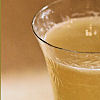




Whiskey Sour
1-1/2 oz fresh lemon juice
2 to 2-1/2 oz whiskey
1/2 to 1-1/2 oz simple syrup
lemon wedge and cherry for garnish
Shake the juice, whiskey, and syrup with ice; strain into a chilled sour glass or rocks glass. Garnish with the lemon wedge and cherry.
Drink of the Week, drinks, recipes
7 Comments »




 Once upon a time, there was a spoiled teenager named Anita who refused to eat ribs, chicken legs, or any other meat shaped like a body part.
Once upon a time, there was a spoiled teenager named Anita who refused to eat ribs, chicken legs, or any other meat shaped like a body part.





















































 Atomic-Age Martini
Atomic-Age Martini Las Vegas is perhaps the last place on the planet you’d expect to find anyone attempting to practice the
Las Vegas is perhaps the last place on the planet you’d expect to find anyone attempting to practice the  I distinctly recall the first time I drank a Whiskey Sour. Our friends Jason and Maggie, eking their way through grad school, lived in East Palo Alto (pre Four Seasons, pre Ikea). Their apartment sat tucked behind a bungalow facing the 101 frontage road. The neighbor who lived in said bungalow was an affable fellow named Drew, a long-haired techie, musician, and tinkerer. The bungalow inevitably became the scene of numerous jam sessions: late-night sing-alongs fueled by a potent mixture of whiskey, powdered sugar, ice, and the juice of the Meyer lemons that grew right outside Drew’s kitchen window… all whizzed up in the blender. (Hey, we were young.)
I distinctly recall the first time I drank a Whiskey Sour. Our friends Jason and Maggie, eking their way through grad school, lived in East Palo Alto (pre Four Seasons, pre Ikea). Their apartment sat tucked behind a bungalow facing the 101 frontage road. The neighbor who lived in said bungalow was an affable fellow named Drew, a long-haired techie, musician, and tinkerer. The bungalow inevitably became the scene of numerous jam sessions: late-night sing-alongs fueled by a potent mixture of whiskey, powdered sugar, ice, and the juice of the Meyer lemons that grew right outside Drew’s kitchen window… all whizzed up in the blender. (Hey, we were young.)



